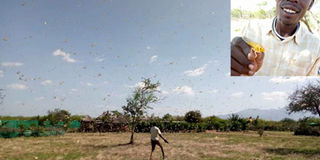Panic as desert locusts invade Uganda

This photos shared on social media show a man trying to scare away the desert locusts in Amudat District on February 2020
Swarms of deadly desert locusts Sunday entered Uganda through Amudat District, Karamoja region, creating panic among the farmers, pastoralists and leaders in the region.
In response, government officials are in a crisis meeting to prepare how to prevent the locusts that have ravaged several parts of Kenya, from spreading to other parts of Uganda.
"I have called an emergency meeting of relevant political leaders& technical officers @OPMUganda at 7pm tonight to immediately swing into action with the preparedness interventions we have been planning to deal with #DesertLocusts," Prime Minister, Dr Ruhakana Rugunda said in a Sunday tweet.
Mr Martin Owor, the Commissioner Disaster Management Office of the Prime Minister, had earlier said that the Amudat District agricultural officer had reported that the locusts were about 4 kilometres away from the Kenya-Uganda border.
Latest reports show that the deadly insects were spotted in several parts of Amudat District at about 2pm on Sunday.
Reports say that the locusts entered Uganda via North West Pokot in Kenya, where they have destroyed hundreds of acres of vegetation.
Mr Robert Adyama, the Amudat District Resident District Commissioner said the locusts have started destroying vegetation.
He said the locusts are still in Okorikeya and Loro villages.
Mr Masokonyi Waiswa, the Amudat District chief administrative officer, said that his office is compiling a status report to the Ministry of Agriculture.
However, State Minister for Karamoja Affairs, Mr Moses Kizige called for calm.
“Right now, the Prime Minister has convened a meeting today at 7pm to prepare a team that will take action,” he said.
Desert locusts, according to United Nations Food and Agriculture Organizations (FAO) have destroyed vegetation in Kenya as they move toward Uganda.
They travel in dense, crackling swarms which can contain as many as 80 million locusts per square kilometre.
FAO says the locusts can live for up to five months, depending on weather and local conditions. They can lay eggs that can hatch after two weeks, with locusts maturing to adulthood in two to four months on average.
They can destroy about 192 million kilogrammes of vegetation in two days.
Mr Owori said that two air spray planes that have been hired, will arrive in Moroto as soon as possible.
According to Mr Owori, motorised sprayers that will be mounted on pickups and tractors are being mobilised to move to Karamoja sub-region.
He said a team of UPDF soldiers and Uganda Wildlife Authority wardens ready to assist officials from the Ministry of agriculture to spray the pests.
He said all the necessary logistical materials that will be used by the teams, have been dispatched to the region.




